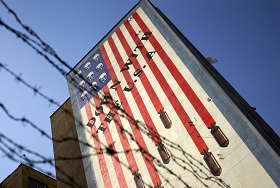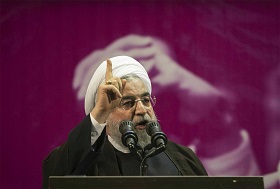The “shamanic dances” around the “spirit” of the Joint Comprehensive Plan of Action (JCPOA) peaked in October, 2017 after U.S. President Donald Trump criticized the deal for its shortcomings and accused Tehran of playing a destructive role in the region. Trump believes that Iran has been suppressing its own citizens for nearly 40 years now, that it has repeatedly behaved aggressively towards U.S. troops and civilians, and that it sponsors terrorism. Nevertheless, Iran has done a much better job at conditioning the public's perception of all the problems that the United States has ever created for the country.
Back during Barack Obama’s presidency, the United States embraced the principle of communicating with the “right” Iranians: modern and progressive representatives who want to change the regime. One would therefore think that the U.S. administration’s recent negative statements about the regime in Iran would be hailed by this target audience. There are, however, two circumstances to consider here. First, Iranians tend to join ranks in the face of an external threat. Second, Trump does not appear to be interested in social engineering the Iranian population.
The EU three (Germany, France and the United Kingdom) support the JCPOA and have called on the U.S. President to reconsider his views. The political differences between the United States and the other actors, which are interested in the preservation of the JCPOA, certainly play into Iran’s hands. Should Washington decide to reactivate the sanctions, or even introduce new sanctions, they will affect actors wishing to return to the Iranian market.
With the numerous unresolved issues between Iran and the United States, any normalization of bilateral relations would require both political will and a large-scale settlement plan.
The “shamanic dances” around the “spirit” of the Joint Comprehensive Plan of Action (JCPOA) peaked in October, 2017 after U.S. President Donald Trump criticized the deal for its shortcomings and accused Tehran of playing a destructive role in the region. Iran is yet again a part of the “axis of evil” identified by President George W. Bush in 2003, albeit the international environment is different.
In July 2015, after a prolonged period of negotiations, the group of international mediators on Iran’s nuclear program was on the verge of finalizing the plan. Observers were jubilant, expecting the problem to be resolved shortly. Sceptics were in the minority. However, the as conflict surrounding the Iranian nuclear dossier did not stem from the nuclear considerations, so why did it have to be resolved with the signing of the nuclear agreement? Sceptics suggested waiting until the agreement is actually implemented. This happened in January 2016, and the parties even released each other’s citizens from custody to mark the occasion. Iranian-born U.S. journalist Jason Rezaian was released as well. Back then, this appeared to be a major step towards de-escalation. But has the regional situation, as well as the United States’ priorities and Washington’s list of grudges against Tehran, changed since the new administration came to power? Sceptics believed that the nuclear program issue would be replaced by some other major axe to grind. They did not have to wait long: now this axe is Iran’s missile program and the country’s destabilizing policy in the region, whose main conduit is the Islamic Revolutionary Guard Corps (IRGC). For as long as U.S. Congress is discussing Trump’s proposals to modify the multilateral accord, optimists will keep hoping that this will remain “an element of internal political discussions within the framework of U.S. national legislation,” as the Ministry of Foreign Affairs of the Russian Federation put it in a statement.
Exchanging Courtesies
Trump took a number of historical facts from the shamanic kit diligently put together by his advisors, facts that were meant to prove that Iran has in fact always been and still is a pariah state and, therefore, one unworthy of trust. The U.S. President believes that Iran has been suppressing its own citizens for nearly 40 years now, ever since the revolution; that it has repeatedly behaved aggressively towards U.S. troops and civilians; and that it is a leading sponsor of such terrorist organisations as Al-Qaeda, the Taliban, Hamas and Hezbollah. “There are also many people who believe that Iran is dealing with North Korea,” Trump stated. Rhetorically, this allows Washington to fall back on the axis-of-evil vocabulary. Furthermore, Trump also said in his statement that the previous U.S. administration had partially lifted the anti-Iranian sanctions just as the regime was about to collapse; therefore, reinstating the sanctions now appears to be a logical move aimed at correcting President Obama’s mistakes.
It should be noted that Iran has done a much better job at halvanizing the public’s perception of all the problems that the United States has ever created for the country, from the pre-arranged coup against the Mohammad Mosaddegh government in 1953 to the downing of a passenger airliner with 290 civilians on board in 1988, after which the U.S. servicemen involved in the incident were decorated.
There is no doubt that Iran is actively pursuing its own interests in the region. However, President of Iran Hassan Rouhani was correct when he mentioned the “pink elephant” in the Middle East, meaning that many conflicts result from Washington's erroneous policies. “You are concerned about Iranian missiles? But do you remember that you sell weapons to criminals who use your aircraft and bombs to kill the people of Yemen?” Rouhani asks, justifying Iran’s course towards protecting its own interests and security.
Prior to Trump’s signing of the Countering America’s Adversaries Through Sanctions Act (H.R.3364) in August 2017, IRGC commander Major General Mohammad Ali Jafari warned that if Washington put the entire IRGC on the list of terrorist organizations (at present, only the IRGC Quds Force, which operates abroad, is listed as being a terrorist organization), then the United States will have to secure all its military bases within a 2000-km radius of Iran. Jafari also noted that, in this case, Iran would declare the U.S. Armed Forces a terrorist organization.
After Trump signed H.R.3364, which is primarily aimed against Iran’s missile program and the IRGC, Tehran started to consider its own bill as a response to the actions of the United States, which ran counter to the spirit of the JCPOA. The bill calls for allocating nearly $900 billion to what Iran considers to be defensive measures: a third for the development of its nuclear program; a third for supporting the operations of the Ministry of Foreign Affairs, the Ministry of Defence and Armed Forces Logistics and the Ministry of Intelligence; and a third for supporting the Quds Force.
Driving a Wedge between the Government and the Nation
It is likely that Trump’s statement about the repressive nature of the Iranian regime and to the threat of putting the IRGC on the list of terrorist organizations prompted Iranian officials to pay so much attention to the U.S. President's attempt to “drive a wedge between the Iranian government and the nation.” Back during Barack Obama’s presidency, the United States embraced the principle of communicating with the “right” Iranians: modern and progressive representatives who want to change the regime. One would therefore think that the U.S. administration’s recent negative statements about the regime in Iran would be hailed by this target audience. There are, however, two circumstances to consider here. First, Iranians tend to join ranks in the face of an external threat, irrespective of their personal attitudes towards the system. Second, Trump does not appear to be interested in social engineering Iran, nor in any deliberate attempts to change the regime. It would be otherwise difficult to explain why he mentioned the “Arab Gulf” in his speech rather than the Persian Gulf – unless the U.S. President does indeed need a lesson in geography, as Rouhani suggested. Minister of Foreign Affairs Mohammad Javad Zarif Khonsari postulated
that Trump’s use of this geographic name was a signal to the United States’ allies in the region. However, a different explanation is also possible. If the “Arab Gulf,” this bait for Iranians’ nationalistic feelings, was mentioned in the same context as Washington’s accusations of the regime and the IRGC, then the United States might be hoping that ordinary Iranians will consolidate around the primary power institutions. In this case, the Trump administration will no longer be required to differentiate between the “right” Iranians and the defendants of the “regime of ayatollahs.” The perception of Iran as the main sponsor of terrorism, in which the regime and the nation are the same, will be cemented.
The result was not long in coming: following the U.S. President’s statement, Iran held a “Message to Trump” campaign, with posters featuring the words “Persian Gulf” in 85 languages. Social networks were full of hashtags like #man_ham_sepahiam (I am an Islamic Revolution Guard) and #ma_hame sepahi_hastim (We all are Islamic Revolution Guards).
Winners and Losers
The JCPOA-sceptic camp is for now winning this dispute, but it does not play first fiddle. The moral victory at the current stage goes to Iran, which is diligently observing the accord, as has been repeatedly confirmed by the International Atomic Energy Agency (IAEA). Furthermore, Iran consistently declares its adherence to the country’s international commitments. On the other hand, on the eve of the U.S. President’s expected refusal to acknowledge Tehran’s compliance with the JCPOA requirements, sceptics urged patience until the EU three and other potential investors in the Iranian economy had reacted. As a result, the EU three expressed their support for the accord, and called on the U.S. President to reconsider his stance. Similar calls came from High Representative of the European Union for Foreign Affairs and Security Policy Federica Mogherini, Director General of the IAEA Yukiya Amano and the Ministry of Foreign Affairs of the Russian Federation, among others. The political differences between the United States and the parties interested in preserving the accord are certainly playing into Iran’s hands. There is, however, a political dimension to the issue. Should Washington decide to reactivate the sanctions, or even introduce new sanctions, they will affect actors wishing to return to the Iranian market, including Total and Peugeot, which have recently signed contracts with Tehran.
We can, therefore, speak of a moral victory, but the question remains as to how the economic players will behave in the worst-case scenario for the JCPOA. Morality, justice and other attributes of the idealistic world are foreign to the Trump administration’s realistic take on the world.
There are a multitude of unresolved issues between Iran and the United States. The interests of the two diverge on plenty of regional topics. Any normalization of bilateral relations would require both political will and a large-scale settlement plan. It appears logical for both parties to continue their attempts to exorcise the JCPOA spirit from the international agenda. It remains to be seen whether Trump will manage to drive the last nail into the coffin of the accord and roll the situation back to the previous status quo.







